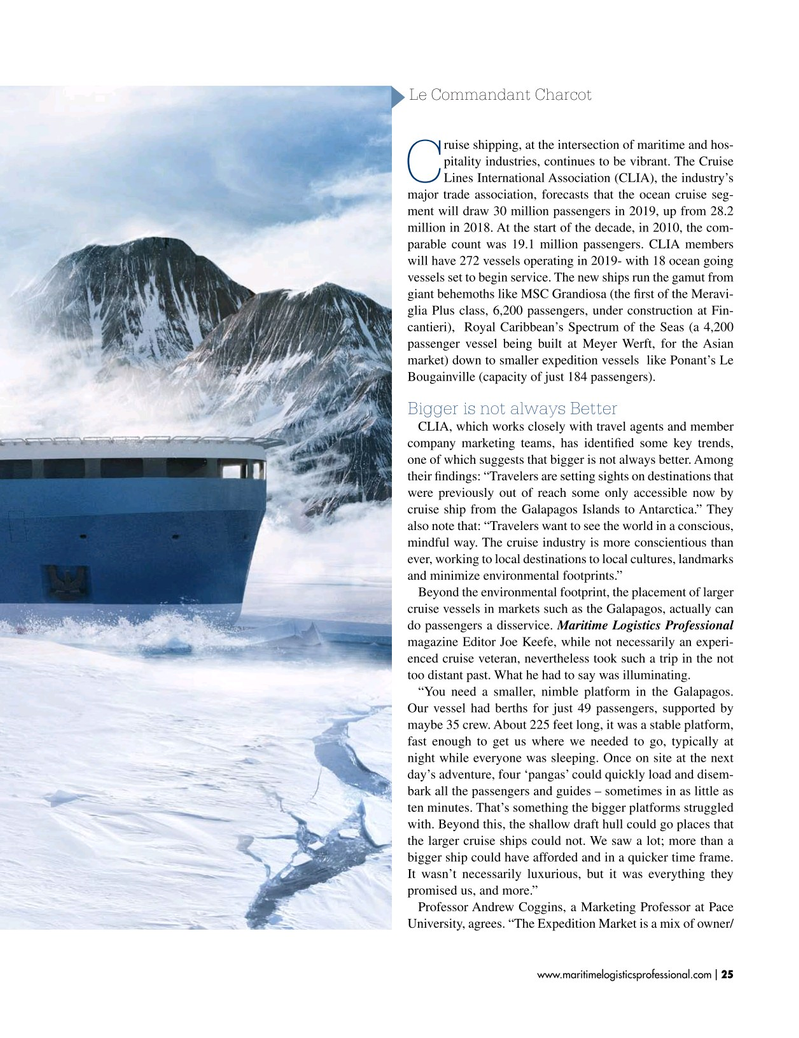
Page 25: of Maritime Logistics Professional Magazine (Jan/Feb 2019)
Cruise Ports Annual
Read this page in Pdf, Flash or Html5 edition of Jan/Feb 2019 Maritime Logistics Professional Magazine
Le Commandant Charcot ruise shipping, at the intersection of maritime and hos- pitality industries, continues to be vibrant. The Cruise
CLines International Association (CLIA), the industry’s major trade association, forecasts that the ocean cruise seg- ment will draw 30 million passengers in 2019, up from 28.2 million in 2018. At the start of the decade, in 2010, the com- parable count was 19.1 million passengers. CLIA members will have 272 vessels operating in 2019- with 18 ocean going vessels set to begin service. The new ships run the gamut from giant behemoths like MSC Grandiosa (the frst of the Meravi- glia Plus class, 6,200 passengers, under construction at Fin- cantieri), Royal Caribbean’s Spectrum of the Seas (a 4,200 passenger vessel being built at Meyer Werft, for the Asian market) down to smaller expedition vessels like Ponant’s Le
Bougainville (capacity of just 184 passengers).
Bigger is not always Better
CLIA, which works closely with travel agents and member company marketing teams, has identifed some key trends, one of which suggests that bigger is not always better. Among their fndings: “Travelers are setting sights on destinations that were previously out of reach some only accessible now by cruise ship from the Galapagos Islands to Antarctica.” They also note that: “Travelers want to see the world in a conscious, mindful way. The cruise industry is more conscientious than ever, working to local destinations to local cultures, landmarks and minimize environmental footprints.”
Beyond the environmental footprint, the placement of larger cruise vessels in markets such as the Galapagos, actually can do passengers a disservice. Maritime Logistics Professional magazine Editor Joe Keefe, while not necessarily an experi- enced cruise veteran, nevertheless took such a trip in the not too distant past. What he had to say was illuminating.
“You need a smaller, nimble platform in the Galapagos.
Our vessel had berths for just 49 passengers, supported by maybe 35 crew. About 225 feet long, it was a stable platform, fast enough to get us where we needed to go, typically at night while everyone was sleeping. Once on site at the next day’s adventure, four ‘pangas’ could quickly load and disem- bark all the passengers and guides – sometimes in as little as ten minutes. That’s something the bigger platforms struggled with. Beyond this, the shallow draft hull could go places that the larger cruise ships could not. We saw a lot; more than a bigger ship could have afforded and in a quicker time frame.
It wasn’t necessarily luxurious, but it was everything they promised us, and more.”
Professor Andrew Coggins, a Marketing Professor at Pace
University, agrees. “The Expedition Market is a mix of owner/ www.maritimelogisticsprofessional.com 25
I

 24
24

 26
26
